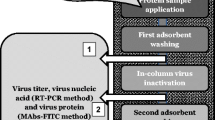Abstract
The purpose of the present study was to examine the efficacy and mechanism of fraction IV cold ethanol fractionation and pasteurization (60°C heat treatment for 10h), involved in the manufacture of albumin from human plasma, in the removal and/or inactivation of the hepatitis A virus (HAV). Samples from the relevant stages of the production process were spiked with HAV and the amount of virus in each fraction then quantified using a 50% tissue culture infectious dose (TCID50). HAV was effectively partitioned from albumin during the fraction IV cold ethanol fractionation with a log reduction factor of 3.43. Pasteurization was also found to be a robust and effective step in inactivating HAV, where the titers were reduced from an initial titer of 7.60 log TCID50 to undetectable levels within 5 h of treatment. The log reduction factor achieved during pasteurization was≽4.76. Therefore, the current results indicate that the production process for albumin has sufficient HAV reducing capacity to achieve a high margin of virus safety.
Similar content being viewed by others
References
Berkman S. A. (1988) Infectious complications of blood transfusion.Blood Rev. 2: 206–210.
Schilt, U. (1989) Overview of viruses relevant to blood transfusion.Curr. Stud. Hematol. Blood Transfus. 56: 1–8.
Cuthbertson, B., K. G. Reid, and P. R. Foster (1991) Viral contamination of human plasma and procedures for preventing virus transmission by plasma products. pp. 385–435. In: J. R. Harris (ed.),Blood separation and plasma fractionation. Willey-Liss., New York, USA.
Cohn, E. J., L. E. Strong, W. L. Hughes Jr D. J. Mulford, J. N. Ashworth, M. Melin, and H. L. Taylor (1946) Preparation and properties of serum and plasma proteins. IV. A system for the separation into fractions of the proteins and lipoprotein components of biological tissues and fluids.J. Am. Chem. Soc. 68: 459–475.
Kim, I. S., H. G. Eo, C. E. Chang, and S. Lee (2000) Partitioning and inactivation of viruses by cold ethanol fractionation and pasteurization during manufacture of albumin from human plasma.J. Microbiol. Biotechnol. 10: 858–864.
Erstad, B. L. (1996) Viral infectivity of albumin and plasma protein fraction.Pharmacotherapy 16: 996–1001.
Roberts, P. (1996) Virus safety of plasma products.Rev. Med. Virol. 6: 25–38.
Tabor, E. (1999) The epidemiology of virus transmission by plasma derivatives: Clinical studies verifying the lack of transmission of hepatitis B and C viruses and HIV type 1.Transfusion 39: 1160–1168.
Federal Health Office and Paul Ehrlich Institute Federal Office for Sera and Vaccines (1994) Notice on the registration of drugs: Requirements for validation studies to demonstrate the virus safety of drugs derived from human blood or plasma.Bundesanzeiger 84: 4742–4744.
International Conference on Harmonisation (1998) Guidance on viral safety evaluation of biotechnology products derived from cell lines of human or animal origin; Availability.Federal Resister 63 (185): 51074–51084.
Kim, I. S., H. G. Eo, C. W. Park, C. E. Chang, and S. Lee (2001) Removal and inactivation of human immunodeficiency virus (HIV-1) by cold ethanol fractionation and pasteurization during the manufacture of albumin and immunoglobulins from human plasma.Biotechnol. Bioprocess Eng. 6: 25–30.
Morgenthaler, J. J. and A. Omar (1993) Partitioning and inactivation of viruses during isolation of albumin and immunoglobulins by cold ethanol fractionation.Dev. Biol. Stand. 81: 185–90.
Henin, Y., V. Marechal, F. Barre-Sinoussi, J. C. Chermann, and J. J. Morgenthaler (1988) Inactivation and partition of human immunodeficiency virus during Kistler and Nitschmann fractionation of human blood plasma.Vox Sang. 54: 78–83.
Wells M. A., A. E. Wittek, J. S. Epstein, C. Marcus-Sekura, S. Daniel, D. L. Tankersley, M. S. Preston, and G. V. Quinnan Jr (1986) Inactivation and partition of human T-cell lymphotrophic virus, type III, during ethanol fractionation of plasma.Transfusion 26: 210–213.
Yei, S., M. W. Yu, and D. L. Tankersley (1992) Partitioning of hepatitis C virus during Cohn-Oncley fractionation of plasma.Transfusion 32: 824–828.
Andrewes, C. (1989)Andrewes’ Viruses of Vertebrates. pp. 120–145. Balliere Tindal, London, UK.
Johnson, Z., L. Thornton, A. Tobin, E. Lawlor, J. Power, I. Hillary, and I. Temperley (1995) An outbreak of hepatitis A among Irish haemophiliacs.Int. J. Epidermol. 24: 821–828.
Robinson, S. M., H. Schwinn, and A. Smith (1992) Clotting factors and hepatitis A.Lancet 340: 1465.
Temperley, I. J., K. P. Cotter, T. J. Walsh, J. Power, and I. B. Hillary (1992) Clotting factors and hepatitis A.Lancet 340: 1466.
Kim, I. S., Y. W. Choi, S. R. Lee, Y. Kang, K. M. Lee, D. H. Park, H. S. Woo, and S. Lee (2002) Removal and inactivation of hepatitis A virus during manufacture of urokinase from human urine.Biotechnol. Bioprocess Eng. 7: 340–346.
Heimburger, N. and H. E. Karges (1989) Strategies to produce virus-safe blood derivatives.Curr. Stud. Hematol. Blood Transfus. 56: 23–33.
Nowak, T., M. Niedrig, D. Bernhardt, and J. Hilfenhaus (1993) Inactivation of HIV, HBV, HCV related viruses and other viruses in human plasma derivatives by pasteurization.Dev. Biol. Stand. 81: 169–176.
Author information
Authors and Affiliations
Corresponding author
Rights and permissions
About this article
Cite this article
Kim, I.S., Choi, Y.W., Lee, S.R. et al. Cold ethanol fractionation and heat inactivation of hepatitis a virus during manufacture of albumin from human plasma. Biotechnol Bioproc E 9, 65–68 (2004). https://doi.org/10.1007/BF02949325
Received:
Accepted:
Issue Date:
DOI: https://doi.org/10.1007/BF02949325




